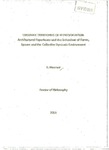UNSTABLE TERRITORIES OF REPRESENTATION: Architectural Experience and the Behaviour of Forms, Spaces and the Collective Dynamic Environment
| dc.contributor.supervisor | Ascott, Roy | |
| dc.contributor.author | Murrani, Sana | |
| dc.contributor.other | Faculty of Arts, Humanities and Business | en_US |
| dc.date.accessioned | 2011-02-10T15:02:07Z | |
| dc.date.available | 2011-02-10T15:02:07Z | |
| dc.date.issued | 2011-01-31 | |
| dc.identifier | 312014 | en_US |
| dc.identifier.uri | http://hdl.handle.net/10026.1/310 | |
| dc.description.abstract |
This thesis applies an interdisciplinary cybernetic and phenomenological analysis to contemporary theories of representation and interpretation of architecture, resulting in a speculative theoretical model of architectural experience as a behavioural system. The methodological model adopted for this research defines the main structure of the thesis where the narrative and the contributing parts of its complexity emerge. The narrative is presented through objectives and hypotheses that shift and slide between architectural representation and its experience based on three key internal components in architecture: the architectural forms and spaces, the active observers that interact with their environment, and finally, the responsive environment. Three interrelated research questions are considered. The first seeks to define the influence of the theoretical instability between complex life processes, emerging technologies and active perception upon architecture. The second questions the way in which the architectural experience is generated. The third asks: Does architecture behave? And if so, is it possible to define its behavioural characteristics related to its representation, experience and the medium of communication in-between? The thesis begins by exploring the effect of developments in digitally interactive, biological, and hybrid technologies on representation in architecture. An account of architectural examples considers the shift in the meaning of representation in architecture from the actual and literal to the more conceptual and experimental, from the individual human body and its relations to the multifaceted ecosystem of collective and connected cultures. The writings of Kester Rattenbury, Neil Leach, and Peter Cook among others contribute to the transformation of the ordinary perceptual experience of architecture, the development of experimental practices in architectural theory, and the dynamism of our perception. The thesis goes on to suggest that instability in architectural representation does not only depend on the internal components of the architectural system but also on the principles and processes of complex systems as well as changes in active perception and our consciousness that act as the external influences on the system. Established theoretical endeavours in biology of D’Arcy Thompson, Alan Turing, and John Holland and philosophies of Merleau-Ponty, Richard Gregory, and Deleuze and Guattari are discussed in this context. Pre-programmed and computational models, illustrative and generative, are presented throughout the thesis. In the final stage of the development of the thesis architecture is analysed as a system. This is not an unprecedented notion, however defining the main elements and components of this system and their interactions and thereafter identifying that the system behaves and defining its behavioural characteristics, adds to the knowledge in the field of theoretical and experimental architecture. This thesis considers the behavioural characteristics of architecture to be derived from the hypothetical links and unstable thresholds of its non-dualistic notions of materiality and immateriality, reality and virtuality, and finally, intentionality and interpretation. | en_US |
| dc.language.iso | en | en_US |
| dc.publisher | University of Plymouth | en_US |
| dc.subject | Architectural Theory | en_US |
| dc.subject | Cybernetics | |
| dc.subject | Post-phenomenology | |
| dc.subject | Representation | |
| dc.subject | Complex System | |
| dc.subject | Active Behaviour | |
| dc.subject | Technoscience | |
| dc.title | UNSTABLE TERRITORIES OF REPRESENTATION: Architectural Experience and the Behaviour of Forms, Spaces and the Collective Dynamic Environment | en_US |
| dc.type | Thesis | |
| dc.identifier.doi | http://dx.doi.org/10.24382/4814 |
Files in this item
This item appears in the following Collection(s)
-
01 Research Theses Main Collection
Research Theses Main


